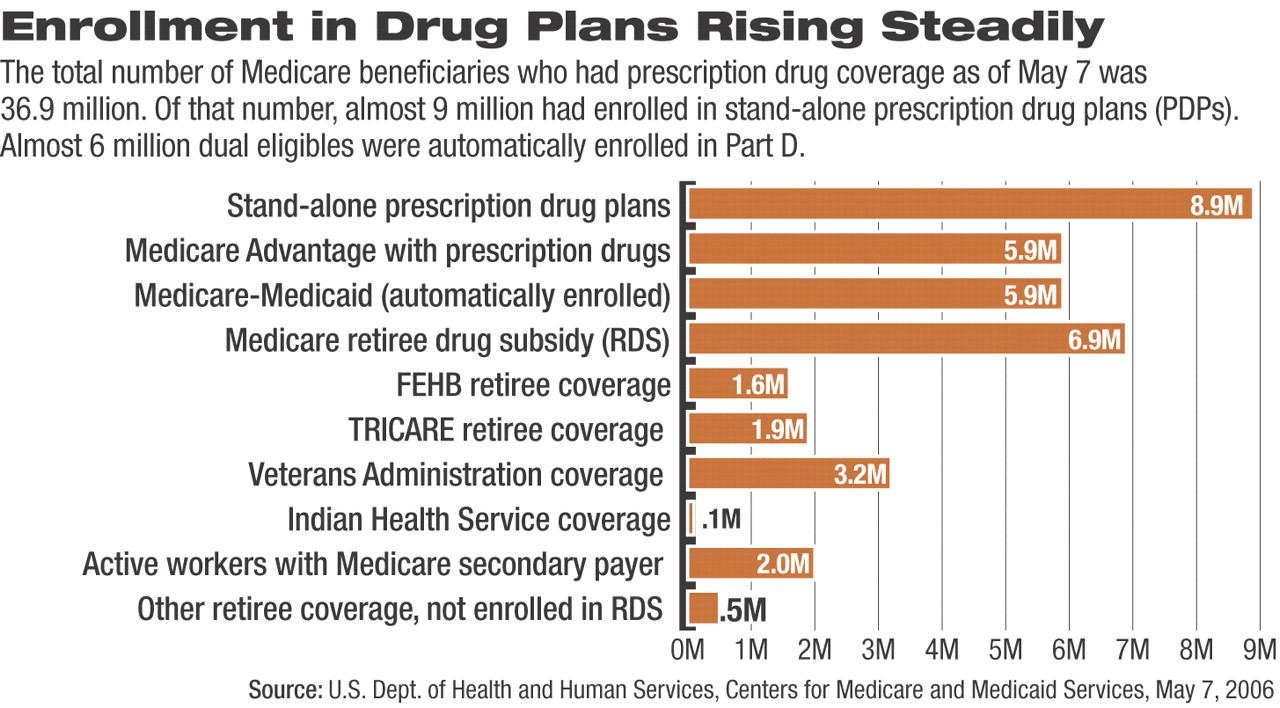More than 90 percent of Medicare beneficiaries now have some form of prescription drug coverage, following a surge in enrollment in the new Part D program in the days prior to the May 15 deadline, according to the Centers for Medicare and Medicaid Services (CMS).
The agency said that when the deadline passed, 38 million out of 43 million Medicare beneficiaries had drug coverage through the new prescription drug plan; the military's health care system, TRICARE; the Federal Employees Health Benefits Program; the Veterans Administration; the Indian Health Service; or other forms of insurance.
Of that 38 million, it appears from CMS numbers released on the agency's Web site that approximately 28 million people are now receiving coverage in the Medicare Part D program. About 8.9 million of those are people who had no coverage prior to January 1 and who have enrolled in stand-alone drug plans under the Part D program. The remainder include about 5.9 million “dual eligibles” who had previously received drug coverage under the Medicaid program and who were auto-enrolled into a new drug plan under Part D by the May 15 deadline; another 5.9 million people in Medicare Advantage who may have been receiving drug coverage under that program prior to January 1 but who are now receiving their benefits through Part D; and about 6.9 million people who have health insurance through an employee retirement plan but who receive a Medicare subsidy for the Part D program (see chart).
The previous tabulation by CMS was issued on May 9, showing 37 million beneficiaries enrolled in some form of drug coverage. Between that time and the May 15 deadline, CMS processed an additional 872,000 enrollments in Part D; that figure does not account for enrollments that may have occurred before the deadline but were not yet processed.
The agency said a “surge of enrollment” in the days prior to the enrollment deadline may have bumped enrollment numbers up to“ significantly more than a million additional beneficiaries.”
CMS reported receiving a record 2.2 million calls to the (800) MEDICARE hotline in the days before the deadline, and more than 15 million page views were logged at<www.medicare.gov>. State and local governments, advocacy groups, seniors' organizations, insurers, and pharmacies held educational and enrollment events to encourage beneficiaries to sign up before the deadline, CMS pointed out.
“As a result, while we are still tabulating final enrollment numbers, more than 38 million people with Medicare—representing more than 90 percent of all beneficiaries— now have coverage for prescription drugs,” said CMS Administrator Mark McClellan, M.D., M.P.H., in a statement.
Not everyone is buying the administration's good news. “No amount of exaggeration can disguise two central facts—over 80 percent of impoverished people with Medicare eligible for a comprehensive drug benefit have not been enrolled, and nearly 51 percent of the people with Medicare who had no drug coverage on January 1, still have no coverage,” said Robert Hayes, president of the Medicare Rights Center, in a statement released just prior to the May 15 deadline.
“The Bush administration today has stated that 6 million people with Medicare lack drug coverage, but there are another 5.8 million people who the administration recently decided to count as having drug coverage,” Hays said. “These numbers include 3.2 million veterans, 2 million working-age seniors, and 600,000 individuals with access to the Indian Health Service. In fact, many of these 5.8 million people do not have drug coverage, and many others of them have signed up for Part D and are thus being counted twice. Even if we assume that half of the 5.8 million have some drug coverage through those other sources, by our conservative analysis about 9 million older adults and disabled Americans still lack drug coverage.”
In related news, a bipartisan group of senators introduced legislation to waive the enrollment penalty for beneficiaries who failed to meet the deadline.
That penalty requires individuals to pay a 1 percent premium increase for each month of delayed enrollment; since the next enrollment period does not begin until November 15, they would pay a minimum late-enrollment penalty of 6 percent. (Beneficiaries who qualify for a low-income subsidy under the drug benefit and beneficiaries who qualify for Medicare because of a disability are exempt from the penalty.)
The proposal, known as the Medicare Late Enrollment Assistance Act (S 2810), would allow Medicare beneficiaries to sign up during the next open-enrollment period without the higher-premium penalty. It also would provide an additional $18 million for counseling to Senior Health Insurance Information Programs and Area Agencies on Aging.
The bill is sponsored by Sens. Charles Grassley (R-Iowa), Max Baucus (D-Mont.), Mike DeWine (R-Ohio), and Bill Nelson (D-Fla.).
“Waiving the enrollment penalty and further enhancing outreach efforts will help even more seniors choose to sign up,” Grassley said at a press conference announcing the bill. “It stands to reason that it takes time for people to learn about benefits available to them. For example, employees with access to 401(k) plans and a generous employer contribution often don't sign up right away, even with a lot of encouragement from their employers.”
“I believe it's right to cut seniors some slack in this first year, when there were too many plans to choose from and more than a few kinks in the program's implementation,” said Baucus, ranking minority member of the Senate Committee on Finance. “This bill is a positive compromise that lets seniors know that if they missed the boat on May 15, there's still some grace available as this benefit gets off the ground.”

